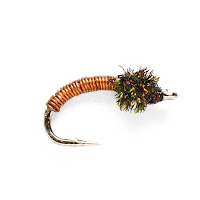In honor of the fast approaching opening day for Wisconsin inland trout season (possibly my favorite time of year), I believe its time to talk about spring creek fly selection and fishing. Before I jump in I'd like to start by saying that I haven't come close to figuring out the drift-less area of Wisconsin - not even close. In fact I never will. The following are simply observations and maybe, hopefully some helpful pointers.
Fly fisherman (especially those who tie flies) like to make things complicated. We like complicated gear contraptions. We like to tie complicated flies. We like technical fly selections that match the anatomical specifications of every insect (at every stage of their life cycle) in the creek. To be fair, particularly in crystal clear spring creeks, that level of specificity can be necessary to catch a fish. I've worked for hours over fish before figuring out the right pattern, in the right size, in the right color. Frankly, in trout fishing, there is no greater sense of accomplishment than when you figure the fish out - you feel as if you've unlocked the rivers secrets, you feel connected. In those occasions I've been glad to have that detailed cripple or emerger.
THE RIG
That being said, I believe we get caught up in the analysis making the outing more about fishing and less about catching (which may be the point but that's another post). I've found you don't need that fancy emerger or six legged size 20 BWO nymph (God help you if you put seven legs on that fly). Although it is worthwhile to have a few on hand, you should approach the creeks in early spring with a bunch of the following: 14-16 prince nymph, 14-18 pheasant tail nymph, 18-20 brassies, 16-20 basic bwo (which is essentially an olive adams), and some adams in the same sizes. Maybe, some scuds. I especially like an orange scud from time to time. I hear people talk about the pink squirrel nymph but I don't love it. I guess to each his own.
My go-to rig is about as fly fishing 101 as it gets. I have a 14-16 prince as the lead fly with a 18-20 brassie trailer. That has led me into hundred fish days and saved the day when nothing else works. All to often, I return to this combo and quickly being to wonder why I ever changed. Oh, and don't worry, this combo bats for average and power. FYI, this combo has worked for me from Colorado to New Zealand. Increase the hook size and it can be a deadly steelhead combo where they've seen far too many glo-bugs.
THE BOTTOM LINE
A good rule of thumb in fly selection is to pick a fly that suggests food generally rather than an attempted carbon-copy of mother nature. You can't paint as well as she can and the trout can tell a forgery for around the next bend. However, if you throw something that looks like a mayfly, a stonefly, a ... well food, the trout will probably give it a try.
All you need is a fly box with a bunch of the basics and a few dandies. In my experience, an accurate cast, a delicate presentation, a gentle step, and silent approach wins the day. If you have those elements working in your favor, then the little drab pheasant tail will have no problem getting you home.
 |
| Pheasant Tail |
 |
| Prince Nymph |
 |
| Brassie |
Tight Lines.